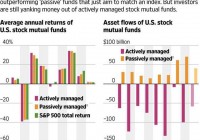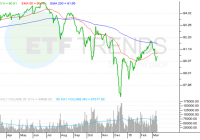Despite The Market Rout, U.S. Fund Investors Pull Out Just $5.5 Billion For The Week
By Tom Roseen During the fund-flows week ended August 26 world markets were whipsawed by concerns of slowing global growth, the devaluation of the Chinese yuan, fears about China’s slowing economy, and the continuing plunge of commodity prices. Oil prices slid below $40/barrel for the first time since February 2009 as a result of a decline in global demand and a glut in oil supply. An early measure of China’s factory activity declined to a six-and-half-year low in August, putting additional pressure on the market. As a result the CBOE Volatility Index (VIX) jumped almost 99%-from 15.25 on Wednesday, August 19, to 30.32 on Wednesday, August 26 (but down from a closing high of 40.74 on Monday, August 24), after the main indices posted their largest weekly declines in four years. During the week the U.S. broad-based indices were down at least 10% from their recent market highs, entering what many define as a market correction. At one point on Monday the Dow Jones Industrial Average declined more than 1,000 points before bouncing back slightly, but it still closed down 588.47 points (3.6%) for the day (its largest one-day percentage decline since August 2011). Despite the People’s Bank of China’s cutting its benchmark interest rate 0.5 percentage point on Tuesday and injecting 150 billion yuan into the financial system to prop up China’s market, the Shanghai composite lost 22.85% during the flows week. Nonetheless, on Wednesday U.S. stocks broke a six-day losing streak and witnessed their largest one-day gain in nearly four years as investors pushed stocks higher on news of the PBOC’s new easing efforts, better-than-expected economic news, and comments by New York Fed President William Dudley that the case for a rate hike in September is less compelling, given the volatility in global markets. As one might expect, given the meltdown in the global markets, fund investors were net redeemers of fund assets (including those of conventional funds and exchange-traded funds [ETFs]); however, they redeemed only a net $5.5 billion for the fund-flows week ended August 26, 2015. Investors redeemed some $17.8 billion from equity funds, $2.6 billion from taxable bond funds, and $345 million from municipal bond funds, but they were net purchasers of money market funds, injecting $15.2 billion for the week. For the first week in three equity ETFs witnessed net outflows, handing back $15.2 billion (their largest amount since the week ended August 6, 2014). With concerns about a slowing global economy, authorized participants (APs) were net redeemers of domestic equity funds (-$10.4 billion), withdrawing money from the group for a sixth consecutive week. They also redeemed money from nondomestic equity funds (-$4.9 billion) for the first week in four. Given the selloff in domestic equities, APs turned their attention to the beleaguered small-cap space and safe-haven plays, with the iShares Russell 2000 ETF (NYSEARCA: IWM ) (+$467 million), the iShares MSCI USA Minimum Volatility ETF (NYSEARCA: USMV ) (+$342 million), and the SPDR Gold Trust ETF (NYSEARCA: GLD ) (+$333 million) attracting the largest amounts of net new money of all individual ETFs. At the other end of the spectrum the SPDR S&P 500 Trust ETF (NYSEARCA: SPY ) (-$4.3 billion) once again experienced the largest net redemptions, while the SPDR Dow Jones Industrial Average ETF (NYSEARCA: DIA ) (-$1.0 billion) suffered the second largest redemptions for the week. For the second consecutive week conventional fund (ex-ETF) investors were net redeemers of equity funds, redeeming $2.6 billion from the group. Domestic equity funds, handing back $1.4 billion, witnessed their seventh consecutive week of net outflows. Meanwhile, their nondomestic equity fund counterparts witnessed $1.2 billion of net outflows-handing back money for the first week in six. On the domestic side investors lightened up on mid- and large-cap funds, redeeming a net $0.5 billion and $0.4 billion, respectively, for the week, while equity income funds attracted some $0.7 billion of net inflows. On the nondomestic side international equity funds witnessed $1.0 billion of net outflows, while global equity funds handed back $0.2 billion. For the fifth week in a row taxable bond funds (ex-ETFs) witnessed net outflows, handing back a little less than $4.7 billion (their largest weekly outflows since the week ended August 5, 2014). Corporate investment-grade debt funds suffered the largest net redemptions, witnessing net outflows of $2.2 billion (for their fifth consecutive week of redemptions), while government-mortgage and government-Treasury & mortgage funds were the only fixed income groups attracting net new money for the week, taking in $452 million and $270 million, respectively. For the fourth week in five municipal debt funds (ex-ETFs) witnessed net outflows, giving back $406 million this past week.

